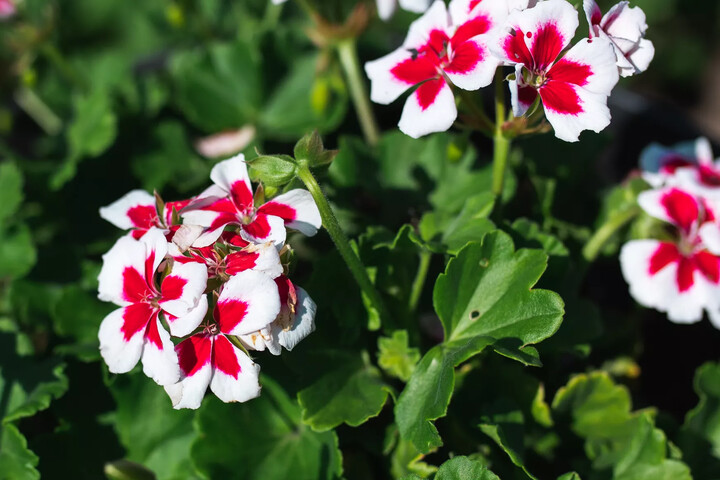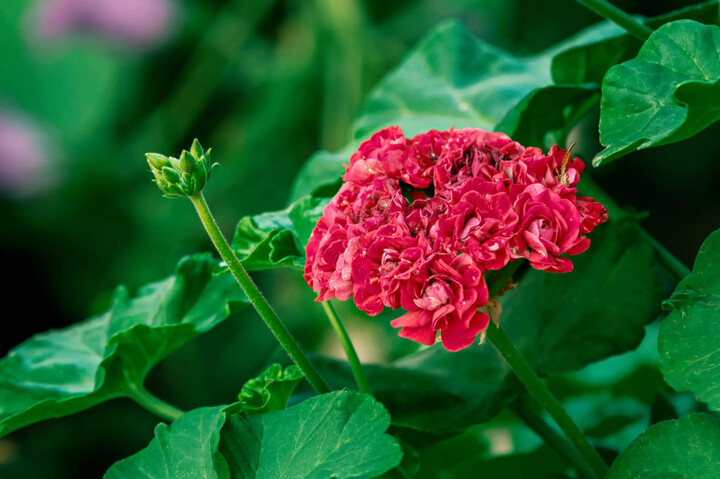Although they are often called geraniums, the familiar annual flowers with red, pink, purple, or white blooms and thick, pleated leaves are not geraniums at all, but rather members of the Pelargonium genus. True members of the geranium genus are often known as cranesbill or hardy geraniums. Originally, both types of plants were part of the Geranium genus, before Pelargonium was designated in 1789. The geranium name, however, persists to this day as the common label for many species of Pelargonium.
The Pelargonium species most often go by the common name annual geraniums or zonal geraniums. These tropical perennials from South Africa are usually grown as annuals, though it is possible to overwinter them in very warm climates. Annual geraniums are favorites for container plantings and hanging baskets, and they also work well as bedding plants.

Botanical Name :Pelargonium spp. and hybrids
Common Names :Annual geranium, zonal geranium, regal geranium, Martha Washington geranium, ivy-leaved geranium
Plant Type :Herbaceous perennial flower, usually grown as an annual
Mature Size :5 to 36 inches tall, depending on variety
Sun Exposure :Full sun; tolerates light shade
Soil Type :Rich, medium-moisture, well-drained soil
Soil pH :5.8 to 6.5; slightly acidic
Bloom Time :Flowers freely throughout season
Flower Color :Red, purple, pink, magenta orange, salmon, white, bicolors
Hardiness Zones :9 to 12; grown as an annual elsewhere
Native Area :Species are from Southern Africa; most are now cultivated hybrids
Toxicity :Toxic to humans and animals
Annual Geranium Care
Annual geraniums are normally planted from potted seedlings. Give them a sunny spot with soil that is rich but well-drained. Most annual geraniums start blooming mid-spring and will repeat bloom until the first frost. It is recommended that you deadhead the entire flower stalk after the flower fades to encourage more blooms.
In climates with cold winters, bedding plants should be pulled up and discarded as soon as frost kills them. Container plants can be brought indoors if you wish. You can grow them as houseplants in a window with bright, direct light. Or, you can overwinter your geraniums in their dormant state—a common strategy for geraniums grown in hanging baskets. Some people take cuttings at the end of the growing season, rooting them indoors, then planting them in potting soil several weeks before outdoor planting time arrives again.
Light
These plants will grow in full sun or partial shade, but they bloom best in full sun punctuated with some shady relief in the hottest hours of the afternoon. Plants that stop blooming in hot weather may just need a little shade for the hottest time of the day.
Soil
Annual geraniums prefer rich but well-drained soil that is slightly acidic—5.8 to 6.5. When growing in containers, use a well-draining general-purpose potting soil—not garden soil.
Water
Stressing the plants slightly by watering only after the soil has been sitting completely dry for a day or two seems to encourage more profuse blooming. These are relatively drought-tolerant plants, which is why they are so popular for cemetery urns that are tended only sporadically. However, do not leave them dry for so long that they start dropping leaves and declining.
Temperature and Humidity
These are warm-region plants that dislike cold temperatures. They thrive at the same temperatures preferred by humans—55 to 80 degrees Fahrenheit. Prolonged temperatures below 55 degrees Fahrenheit will stunt these plants, and temperatures at the freezing point usually kills them. It may be possible to overwinter annual geraniums as far north as zone 7 if you cover them heavily in the winter, but it is generally best to grow them as annuals.
Fertilizer
Zonal geraniums are not heavy feeders, but since they are usually grown in containers, a light feeding with your favorite fertilizer, every two to four weeks, will keep them vigorous.
Is Annual Geranium Toxic?
Many types of Pelargonium are toxic to humans and animals, including dogs, cats, and horses. The toxic parts of the plants are the leaves, which can also cause contact dermatitis. Symptoms related to ingestion include vomiting, depression, anorexia, and gastrointestinal upset. Ingesting large quantities of leaves can cause hypothermia and muscle weakness, primarily in cats.
Varieties of Annual Geraniums
Although there are more than 200 Pelargonium species, only a few are used as the common annual geraniums for ornamental gardening:
Pelargonium x hortum: This is the most common form, the zonal geranium that is so often planted in patio pots and cemetery plantings, and also as a garden bedding plant. Flowers are generally solid tones of red, purple, pink, salmon, magenta, white, or bicolors. The leaves are oval, growing on succulent stems. Flowers can be single with five petals, or double. The common name "zonal geraniums" derives from the area of red, blue, or purple color that stripes through the middle of the leaves. These color zones are more visible in some cultivars and nearly invisible in others.
Pelargonium paltatum: This is ivy-leaved geranium, which looks very similar to zonal geraniums but with a trailing habit that works well in hanging baskets and window boxes. Flowers are usually solid tones of pink, red, lilac, or white.
Pelargonium × domesticum: Known as Regal or Martha Washington geraniums, these are larger plants with large, crinkled leaves. Plants are upright with woody stems, growing to 3 feet or more. These plants are derived from a hybrid of P. grandiflorum and P. cucullatum, and the flowers often have a distinctive speckled look that is different from the more solid colors of other annual geraniums. A miniature version of this type is known as the angel geranium.
Pelargonium domesticum: Scent-leaved geraniums get their fragrance from the oil in their leaves. They can mimic all kinds of scents, including lemon, rose, mint, pine, fruits, and even chocolate. The flowers tend to be small and often insignificant, and the leaf shapes will vary. Besides their ornamental and fragrant appeal, many can also be used in cooking.
Annual Geranium Cultivars
Every year, it seems that there are more Pelargonium hybrids to choose from. There are annual geraniums that are tulip-flowered, cactus-flowered, and some with spiky star-shaped flowers. There are also the fancy-leaved varieties, grown more for their variegated and patterned foliage.
'Appleblossom Rosebud': Pom-pom flowers in a pink and white bicolor
'Black Velvet Rose': Dark, chocolate-brown leaves with only a narrow band of green and bright rose-pink flowers
'Calliope Dark Red': A cross between zonal and ivy-leaved, with double, dark-red flowers
'Divas Orange Ice': An F1 hybrid with bi-colored white and soft orange flowers that look like creamsicles

Growing in Containers
Annual geraniums are a very popular plant for patio containers, hanging baskets, and window boxes. Make sure the container has plenty of drainage holes. Annual geraniums actually bloom a little better when slightly root-bound, so a smallish pot is fine for these plants. When grown in containers, the plants need to be fed more often than when grown as bedding plants.
Propagating Annual Geraniums
You can start zonal geraniums from seed, cuttings, or transplants. Taking cuttings is a traditional method of propagating geraniums and maintaining favorite varieties.
Propagating With Cuttings
If you choose to take cuttings, make sure you only use healthy, vigorous plants.
Take a short cutting with several leaves and stick the end of the cutting into a pot of warm, damp, sterile potting soil.
Keep the pot moist and place it in a bright location out of direct sunlight as roots become well established.
Keep the plant well watered but not soggy, and feed it weekly with a weak houseplant fertilizer solution.
As spring arrives, harden off young plants by giving them progressively longer visits outdoors over seven days before planting them outdoors. They should begin to bloom about a month after being set out.
Growing From Seed
Most geraniums are F1 hybrids that will not come true from seeds taken from the plants. If you choose to grow commercial seeds, be aware that these slow-growing plants can take as long as 16 weeks from planting to flowering. For an early May planting date, for example, you'll need to start seeds in January.
Fill a planting tray with moistened seed-starting mix and sow the seeds over the surface. Add a thin dusting of additional seed-starting mix over the tops of the seeds.
Cover the tray with plastic wrap or a clear plastic dome, then set the tray in a bright area where temperatures are consistently between 72 and 76 degrees Fahrenheit.
When the seedlings sprout, begin removing the dome for short periods each day to allow moisture to escape and to prevent damping-off fungus.
When the seedlings have at least two sets of true leaves, transplant them into their own small pots, burying the cotyledon leaves under the soil.
Place the plants in a very bright location or under grow lights and water them daily. Feed the seedlings weekly with a very weak houseplant food dilution.
As spring arrives, harden off the plants for 7 days before transplanting them outdoors.
Common Pests and Diseases
Annual geraniums can be problematic to grow in very warm, humid climates, where they can be very susceptible to leaf spots and gray mold. These fungal problems can be combatted by pruning the plant to improve air circulation or using copper-soap fungicides. Make sure to water slowly at soil level and avoid splashing soil onto the leaves.
Annual geraniums can also be susceptible to white flies and aphids. Insecticidal soap, then a water rinse applied after the soap has dried, is an effective treatment for these pests. Webs or parched leaves are signs of spider mites. Treat for these as soon as possible. Isolate affected plants from any others, and apply a one-percent solution of neem oil spray, soaking the plant and the soil.